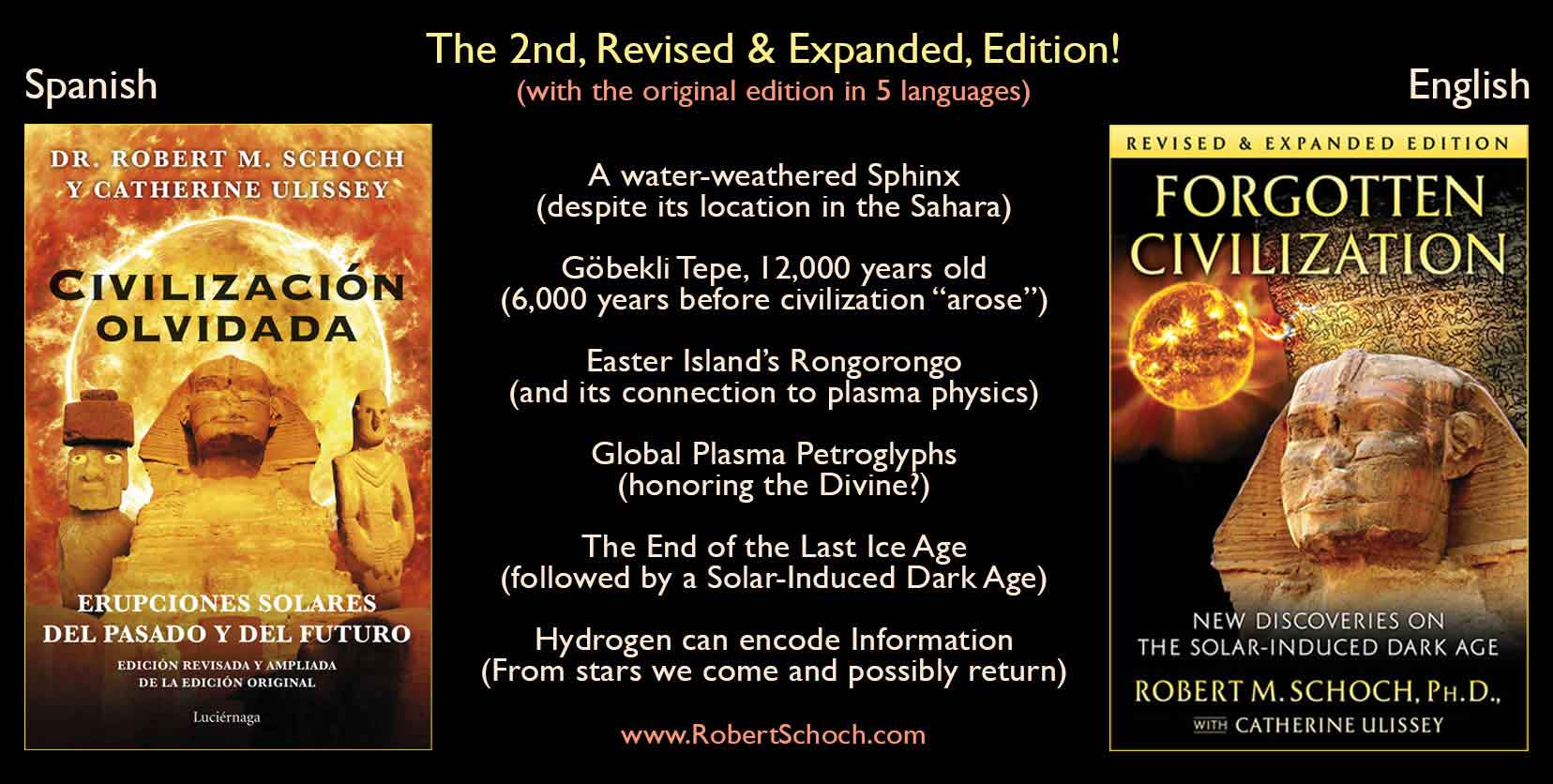Offered by Robert M. Schoch, Ph.D., and Catherine Ulissey:
In an effort to introduce our work to a larger audience, we spent some time recently making some memes, which we then posted to our various social media pages. (We are on Facebook and Twitter primarily; we have Instagram accounts but regrettably find little time to engage there.) For those who may have missed them, we offer the memes again here. Feel free to share them with anyone whom you think might enjoy them. Most of these topics we discuss in Forgotten Civilization. We recommend the book's 2nd, updated and expanded, edition (2021), subtitled New Discoveries on the Solar-Induced Dark Age.
For those who might like to follow us on social media, my handle is
@RobertSchochPhD
and Katie's is @CUlissey.
Follows
and likes
are always appreciated.
These memes are in a slight / loose order in terms of subject matter, with a few supplemental topics
interspersed. This page may take a little longer than normal to load, as we posted slightly higher than
normal (for webpages) sized jpegs. To enlarge the images even more, right-click on your computer and choose
view image
.
The Great Sphinx:
Now, as we post to our website, over thirty years have passed since I first presented my work on the re-dating of the Great Sphinx in various academic forums.
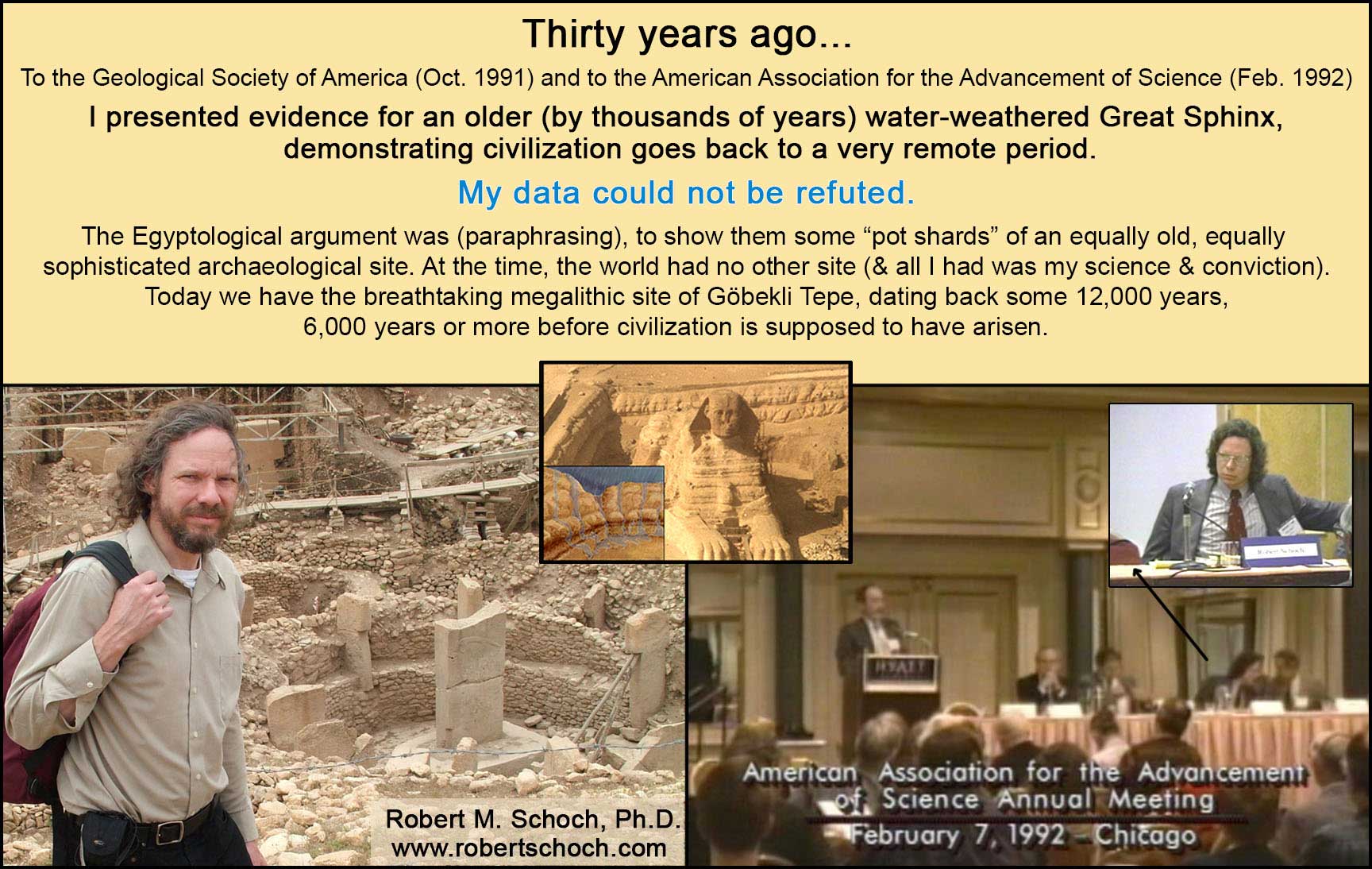
John Anthony West – My Friend for Thirty Years:
Through our work together in Egypt, John Anthony West and I became friends. Our lives intertwined for decades. Below are some photos from trips we took together to Egypt, Turkey, and Norway. We also enjoyed many hours conversing over interesting topics at his home in upstate New York. I miss him a great deal. Shortly after he passed away, I posted this Tribute to My Friend here on this website (clicking the image below will also take you to that tribute).
So as to remember the joy JAW brought to all of us more than the sorrow we feel at losing him, I offer this lighthearted video clip (just 4 minutes and 35 seconds in length) of John Anthony West introducing me at a conference. His introduction was a humorous recollection of how he and I first met. I believe it may bring a smile to you now, as it did to audiences in 2007. Attending that Conference on Precession and Ancient Knowledge (CPAK) back then was Katie, who became my wife in 2010 (we had the great good fortune to be married on Easter Island, the first wedding of that year). Cherished memories, all of them!
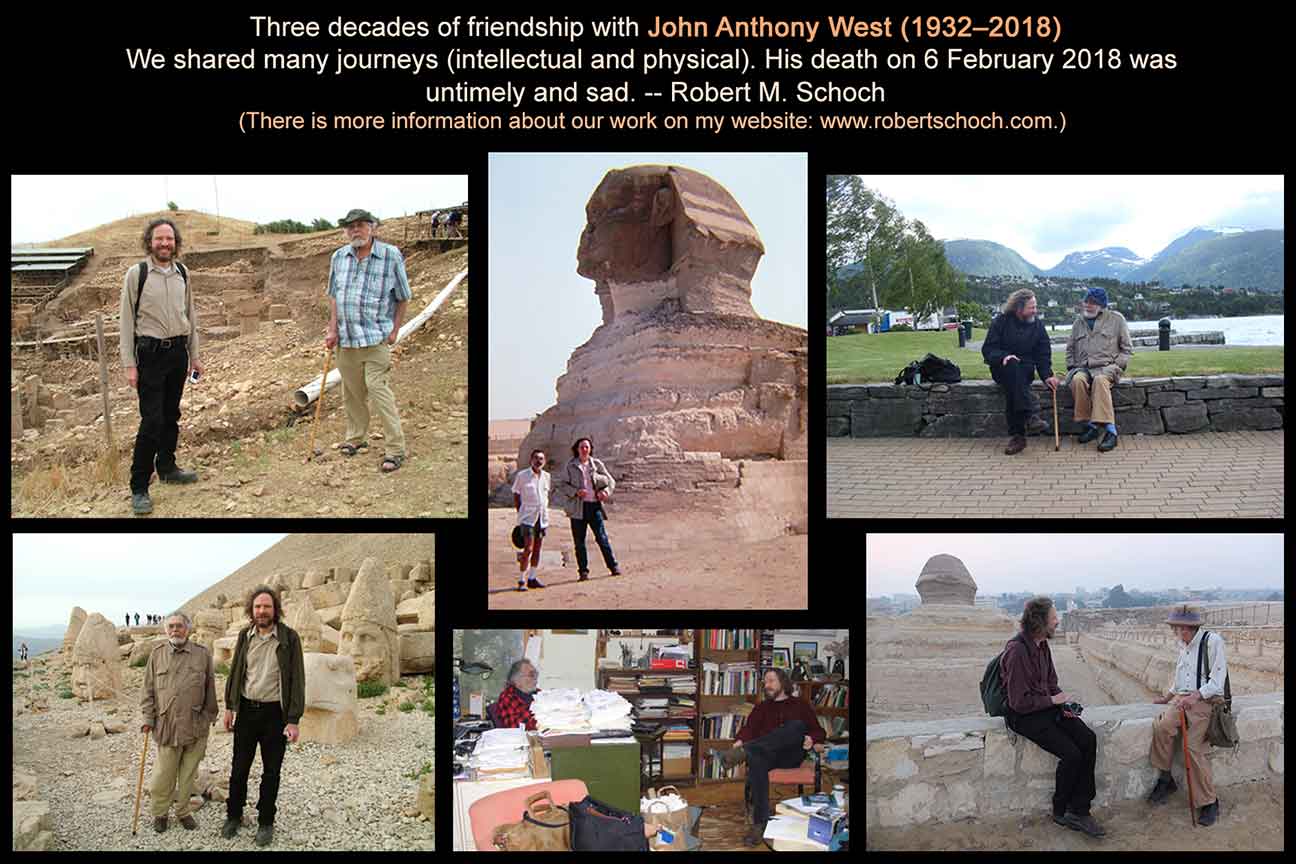
Geology 101 – Erosion by Wind versus Water:
The geology at the heart of the Sphinx firestorm is really quite simple. Seen on the Giza
Plateau, at sites just a stone's throw from each other, are structures that display two very different
types of weathering features: 1) Water weathering (via rain coming down from above, not Nile flooding)
is observable on the body of the Sphinx and, even more so, on the walls of the Sphinx enclosure.
Water beating down upon the rock created the rolling, undulating surfaces (taking with it more material
from the softer layers) and also the deep vertical fissures. 2) Just up and to the left of the Sphinx
enclosure, as seen in this meme, are structures dated to the same period by traditional Egyptologists,
yet they display only wind erosion features (the distinct wind tunnel
that is created when wind
whips about, scouring material from the softer layers of rock). To date these structures, as Egyptologist
do, to the same period of time (and climatic regime) is to simply refuse to confront the science, the data.
As I put forth in
my book,
I suspect a solar event ended Earth's last ice age c. 9700 BCE. Fire (scorching plasma) melted glaciers and
pumped massive amounts of moisture into the air, which then poured down, weathering this monument in prehistory.
Subsequently, a Solar-Induced Dark Age, which my wife and I call SIDA
, set in and the sands of the Sahara
filled in the enclosure, preserving the ancient weathering for us to find now and hopefully learn from.
A high civilization was here on this Earth before us, and it was wiped out by the fury our Sun unleashed.
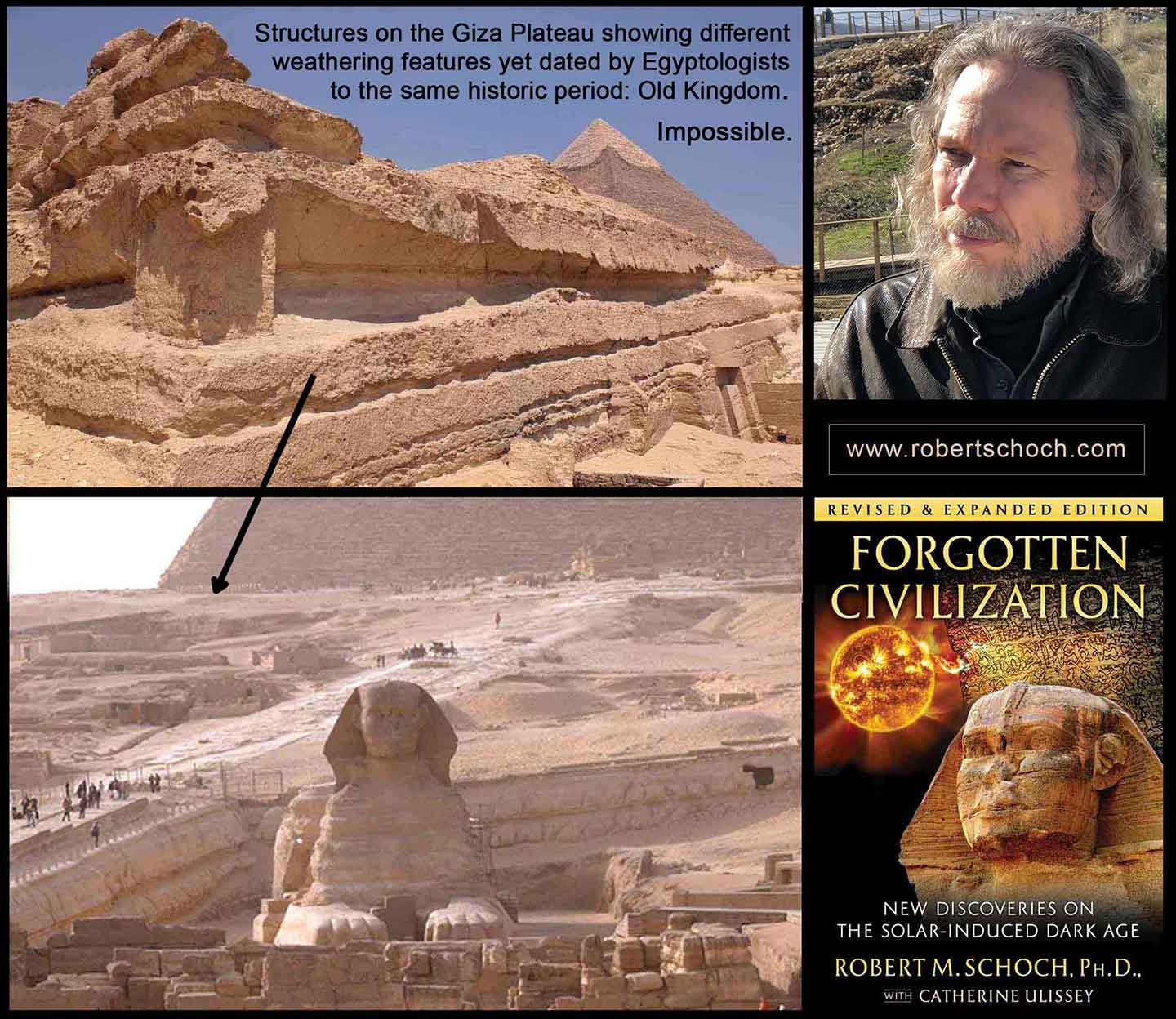
Astrophysicist Thomas Gold on Solar Outbursts:
The late astrophysicist Thomas Gold, who identified vitrification on the Moon when studying lunar data collected by an Apollo mission, speculated on what a massive solar outburst would mean for Earth. I have identified extensive vitrification (melted and re-congealed rocks), which I believe came from such an event, in numerous places on the Giza Plateau.
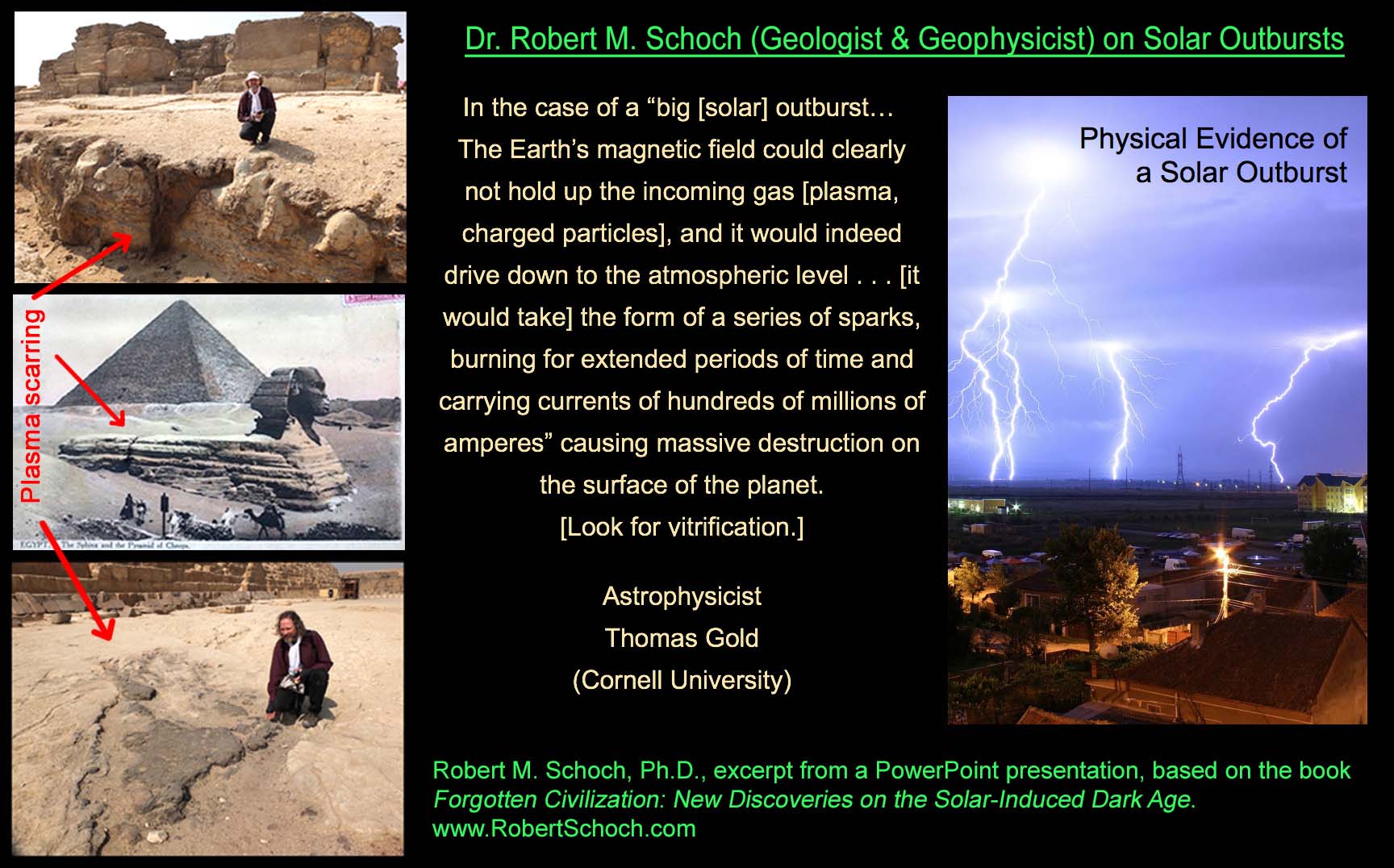
Plasma Scorching on the Giza Plateau:
The Inventory Stela, found near the Temple of Isis on the Giza Plateau, speaks of the
Pharaoh Khufu going to see the thunderbolt
that struck the Great Sphinx and the area surrounding it.
What is wrong with this account etched in stone? According to modern conventional Egyptology, the Sphinx had
not yet been carved during Khufu's reign. Because of this incongruity, Egyptologists claim the stela is wrong,
not them.
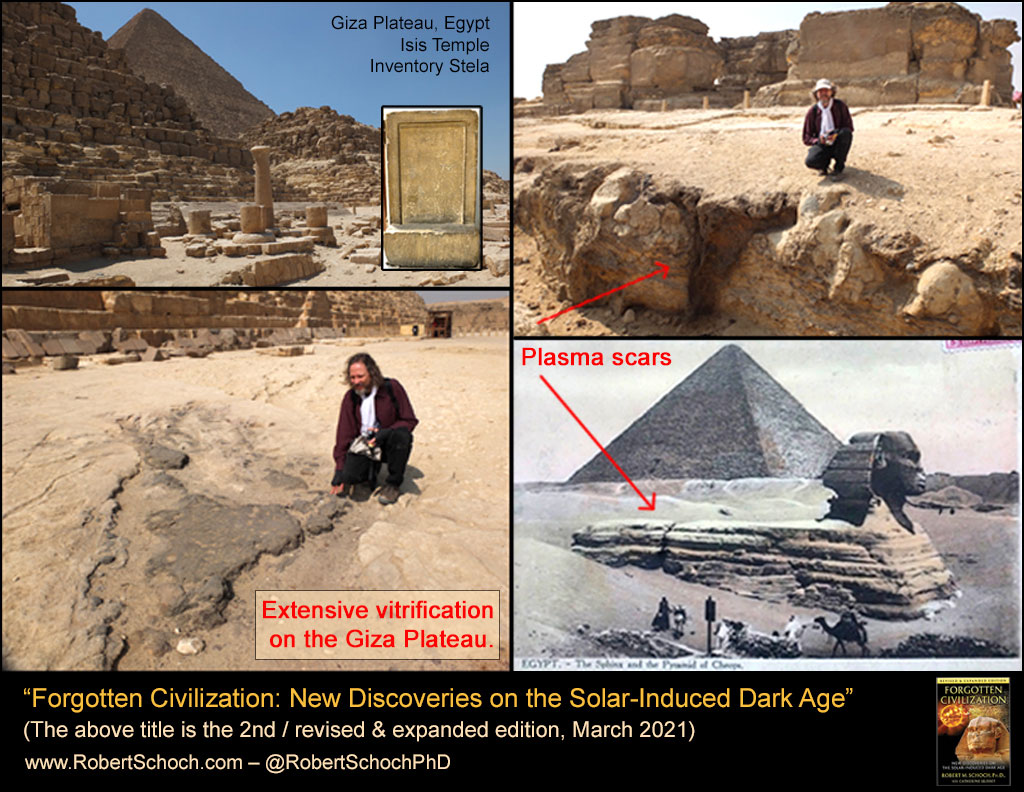
The Giza Pyramids Cap Ancient Lightning Strikes!
During a recent visit to the Giza Plateau, Katie and I believe we made another extremely important discovery. I have been studying scoria at various locations on the Plateau, indicative of (evidence of) a massive solar outburst (micro-nova) in prehistory. I believe this best explains the rapid ending of the ice age circa 9700 BCE and the decimation of high civilization at that time. Visiting the Plateau we noticed enormous Lichtenberg figures/patterns emerging from beneath the Great Pyramid and also the Second Pyramid (we did not have time to inspect the area around the Menkaure Pyramid, but we suspect we will find the same there). Anyone who has walked the Plateau cannot help but to notice all the deep channels that run across it. People suggest their connection is to water, but we believe they are simply the remains of veins of vitrification. Over time (and from the pounding of horse, camel, and other hoofs, not to mention the plethora of tourists through the eons) the fragile natural glass was pounded out, leaving the channels. Please click here to read our short and illustrative article about this new discovery, which we feel is extremely important.
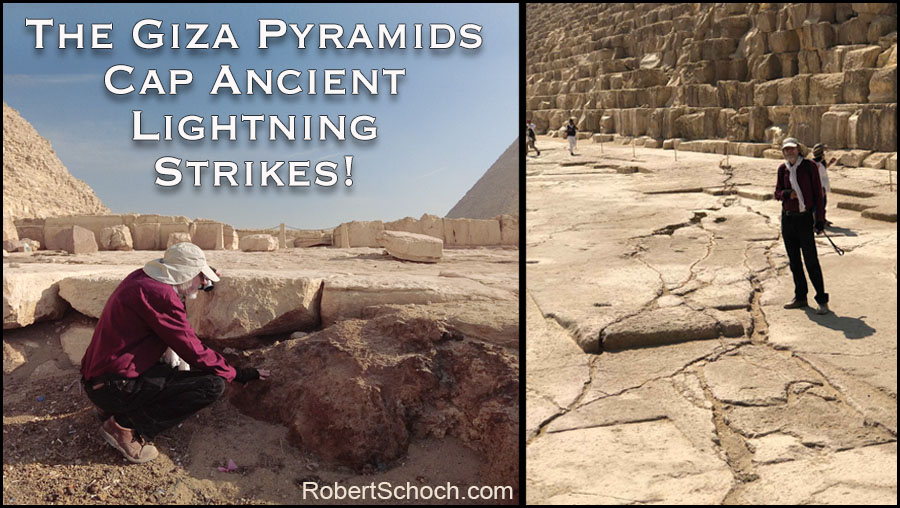
An Easter Island Legend:
This ancient Easter Island legend seems to recall a great solar event, a focus of my research for the last thirteen years (Forgotten Civilization offers many other references to fire, floods, and related topics in antiquity).
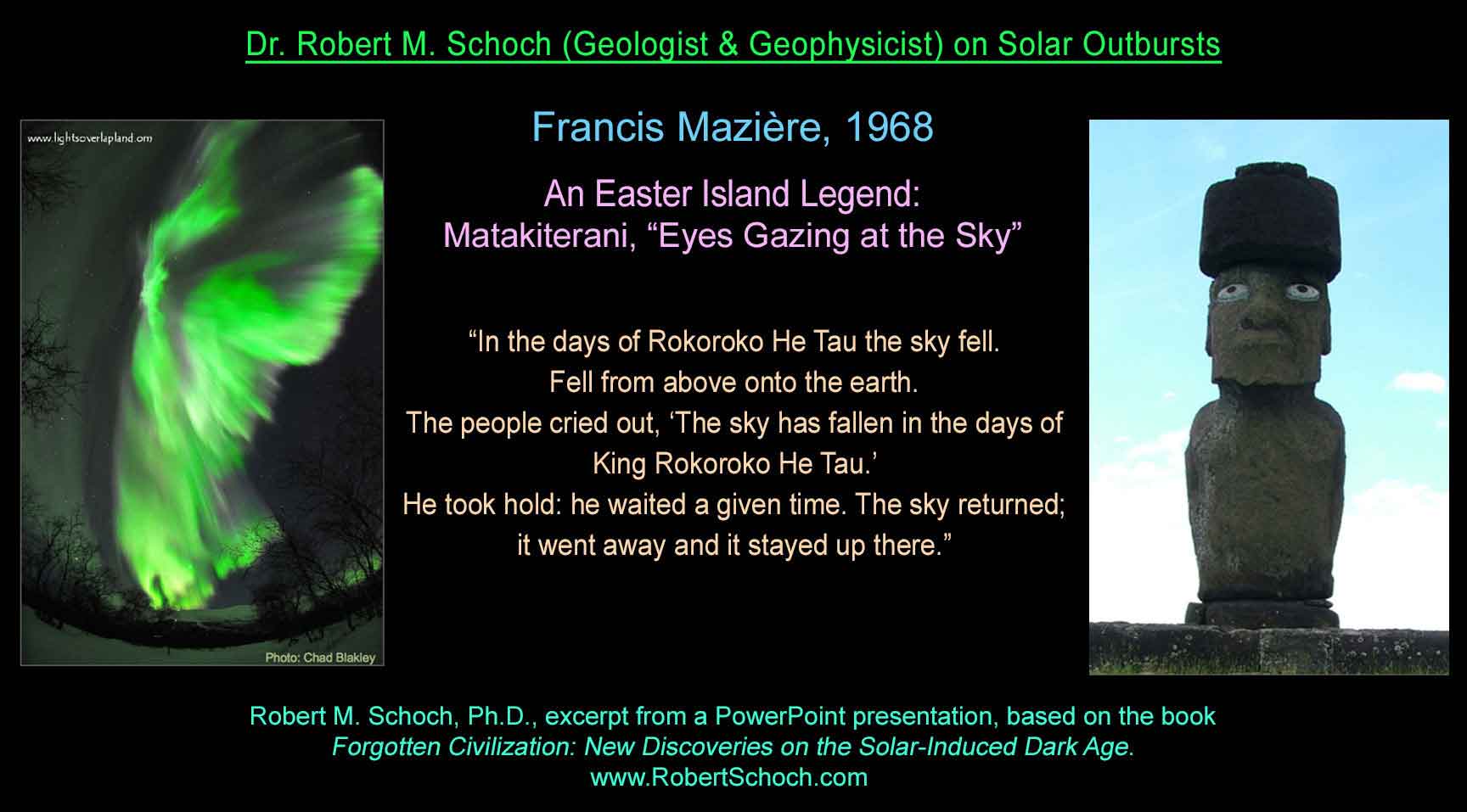
Meeting with Dr. Klaus Schmidt on site at Göbekli Tepe:
Regarding the firestorm that erupted following the GSA (Geological Society of America) and AAAS (American Association for the Advancement of Science) presentations in the early 1990s, Göbekli Tepe really does silence the argument -- except that it has not for everyone. Rather, I have sensed little more than silence coming from the Egyptological and archaeological communities regarding this megalithic site that dates to 6,000 years before civilization is supposed to have arisen. It is a shame, for Göbekli Tepe is vast, displays all the hallmarks of civilization, and dates to the end of Earth's last ice age, c. 9700 BCE (that appears to be the time the site was intentionally buried). It was a pleasure to meet with the late Dr. Schmidt on site to discuss various aspects of the dating, stratigraphy, the stone circles, etc.
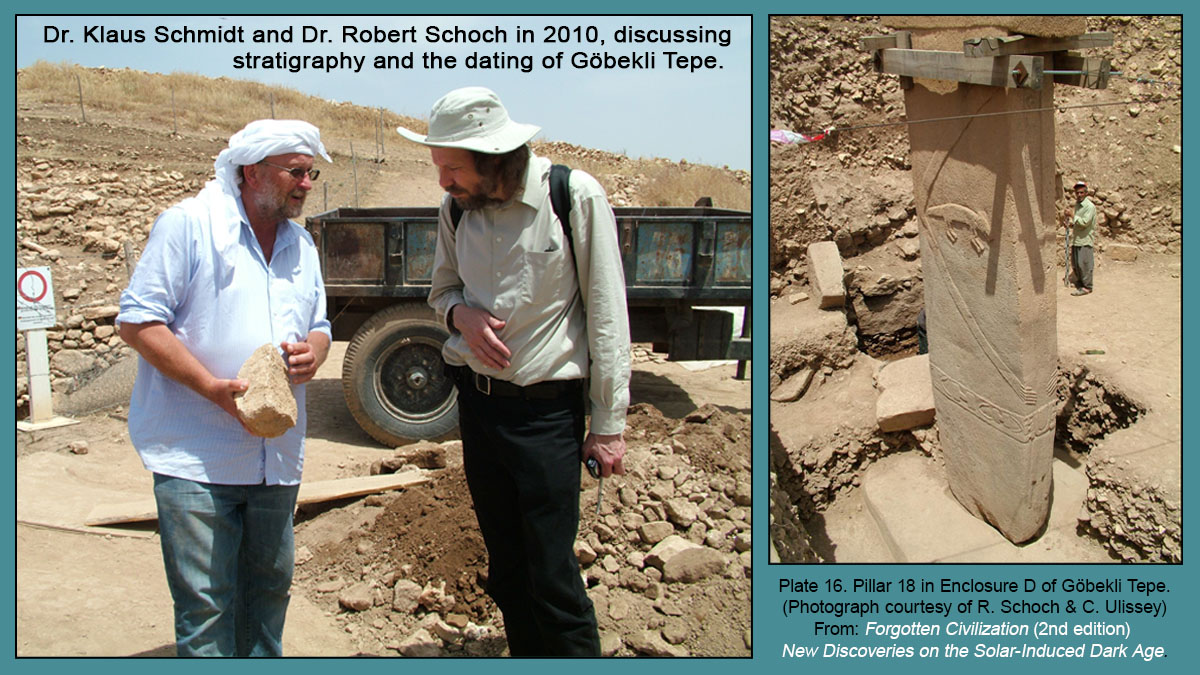
Göbekli Tepe was Intentionally Buried in Ancient Times:
There is no doubt about it; the site speaks for itself. I spoke with Dr. Klaus Schmidt, the lead archaeologist there in 2010. This was his conclusion as well.
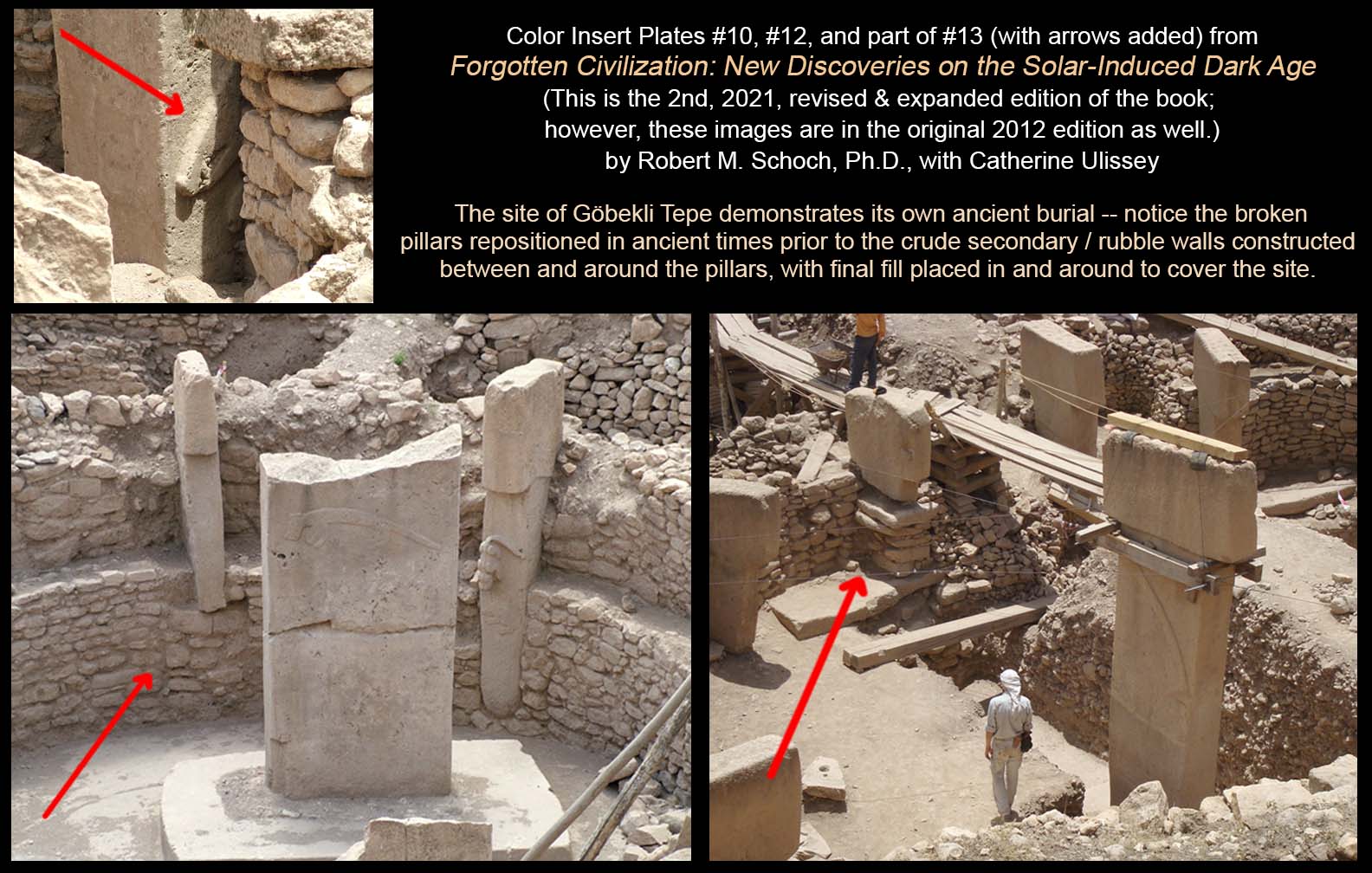
Packed for Posterity: The Ancient and Intentional Burial of Egypt (in similar fashion to Göbekli Tepe):
Katie and I believe we have made an important new discovery (and accompanying hypothesis) regarding ancient Egypt, which we share with you here via this meme and also its accompanying article. (We made the discovery several years ago, in 2019, but it has taken us time to post it on our website. We are also expanding on it for inclusion in a future book.) In a nutshell: We believe that many of the oldest and most magnificent structures in Egypt may have been intentionally buried during very remote times – in a similar fashion to Göbekli Tepe. The primary difference is that Göbekli Tepe remained undisturbed (relatively pristine) until its recent excavations. This has not been the case with Egypt. We hope you will enjoy the work we have done. Please click this link, or on the image, to read the full article.
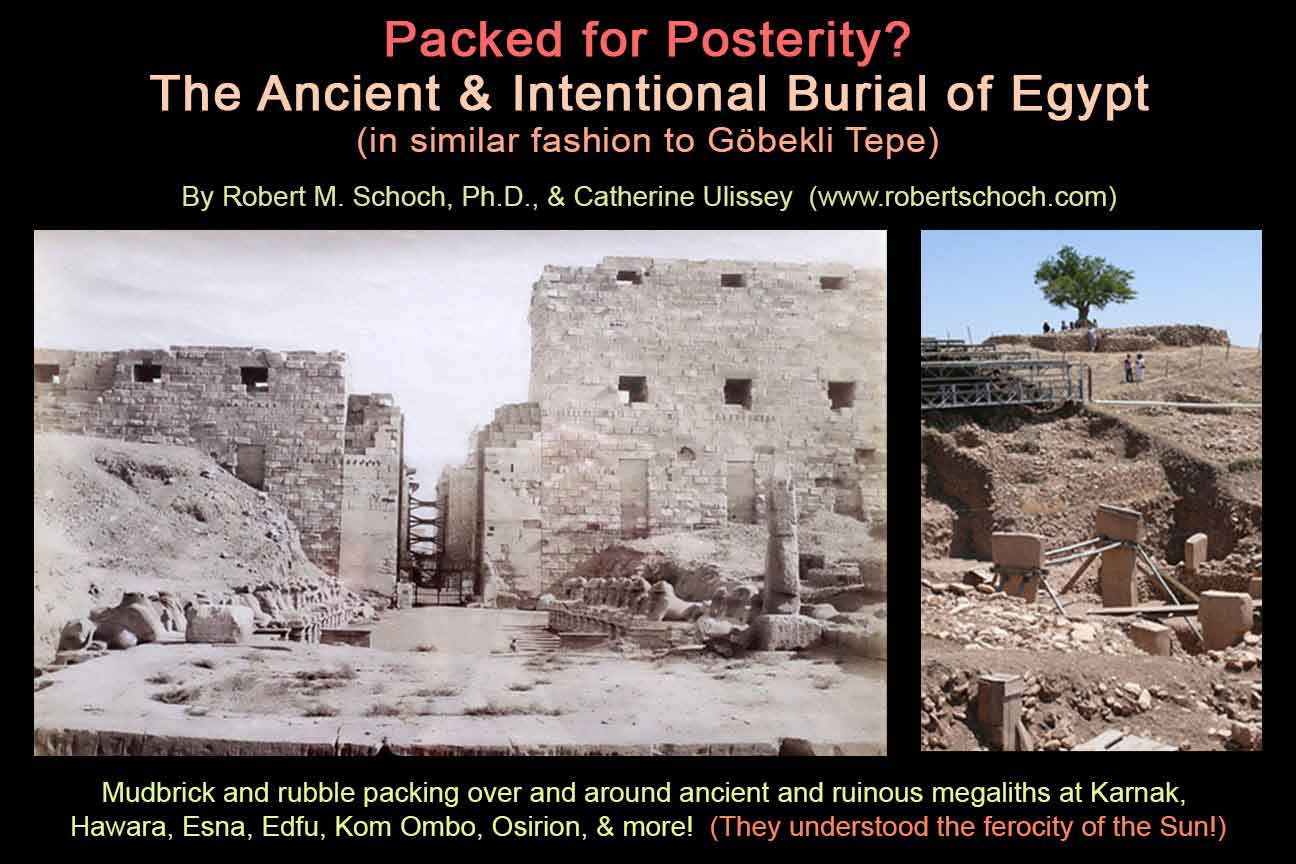
Global Plasma Petroglyphs:
First identified by plasma physicist Dr. Anthony Peratt of Los Alamos National Laboratory, this is one of the most interesting lines of evidence pointing to solar outbursts ending the last ice age (simultaneously decimating the high civilizations of the time). Plasma at high intensity takes various diagnostic shapes. Following a massive solar outburst, these shapes would have been seen in the sky (like the aurora borealis on steroids). Ancient people witnessed such an event, so Dr. Peratt believes (I do as well), and recorded those shapes on rocks and in art seen all over the ancient world. This line of evidence for ancient solar outbursts is supported by more empirical data, such as ice and sediment cores, lunar data, isotopes found in tree rings, etc. Furthermore, Katie and I expanded on this mystery from antiquity by connecting the origins of Easter Island's previously undeciphered rongorongo script to plasma and Dr. Peratt's work. (Shortly after we published this discovery we received an email from a member of Dr. Peratt's team confirming that they too had made the discovery years before we did, but they never published on it.)
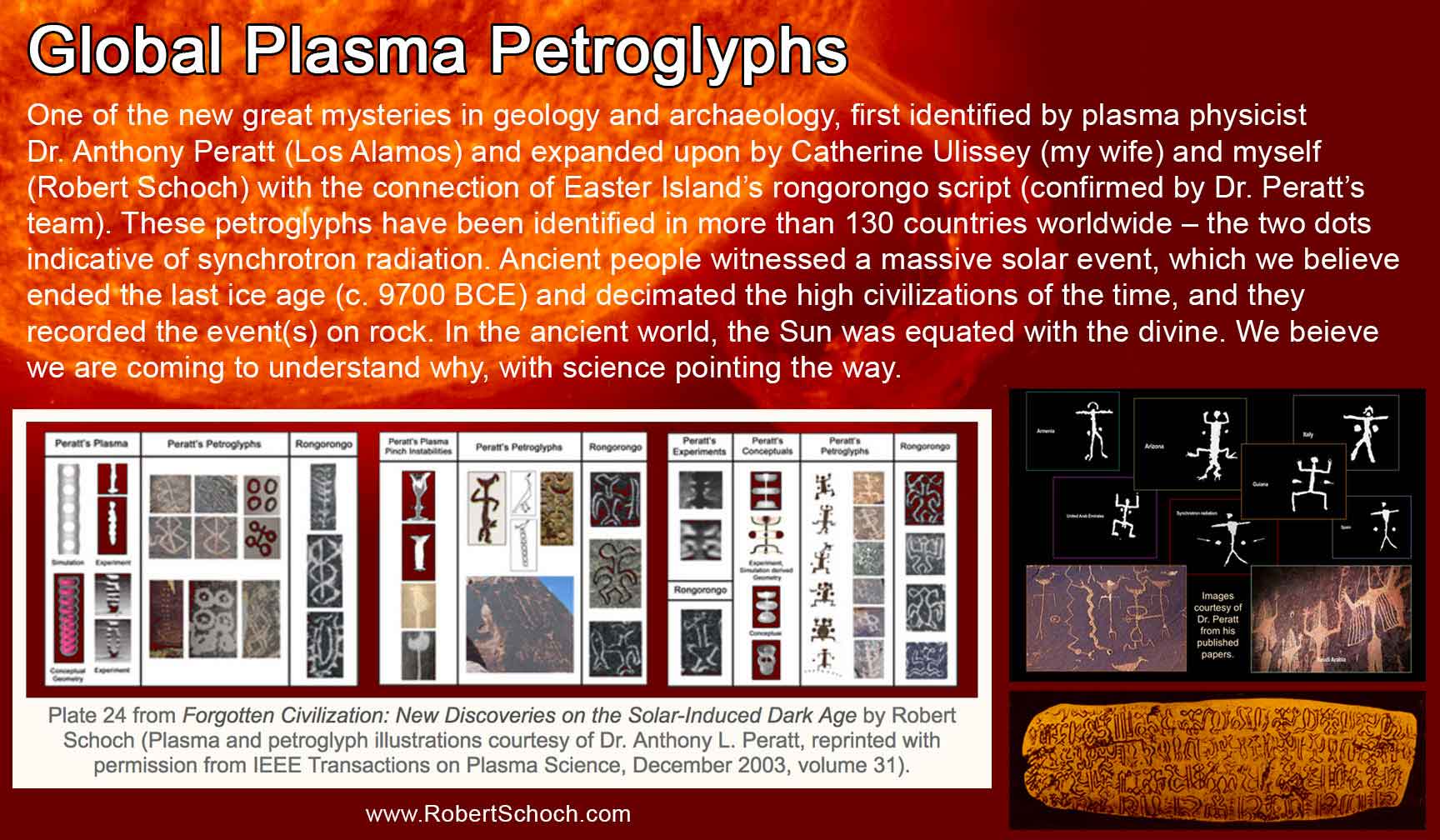
Plasma Configurations Seemingly Everywhere:
Why? We suspect that some ancient people knew more about the Sun and cosmos than we do today. Ancient people both feared and revered the Sun; many worshiped it as a physical manifestation of the Divine: God. We mean no offense to anyone's spiritual beliefs; we are simply following the data as we come upon it and are making the best extrapolations from it that we can.
Dr. Peratt's work teaches that plasma at high intensity takes on distinctive shapes. And here is the BIG connective issue: Nobel Laureate Dr. Luc Montagnier demonstrated (via DNA replication in water) that hydrogen can encode information. We suspect that plasma (hydrogen, but with its proton and electron stripped of each other, creating charged / ionized particles or plasmas) might be the conscious web that binds the universe -- the ancient understanding (or concept) of what God is. (God is within everything, and all around, as is hydrogen and plasma.)
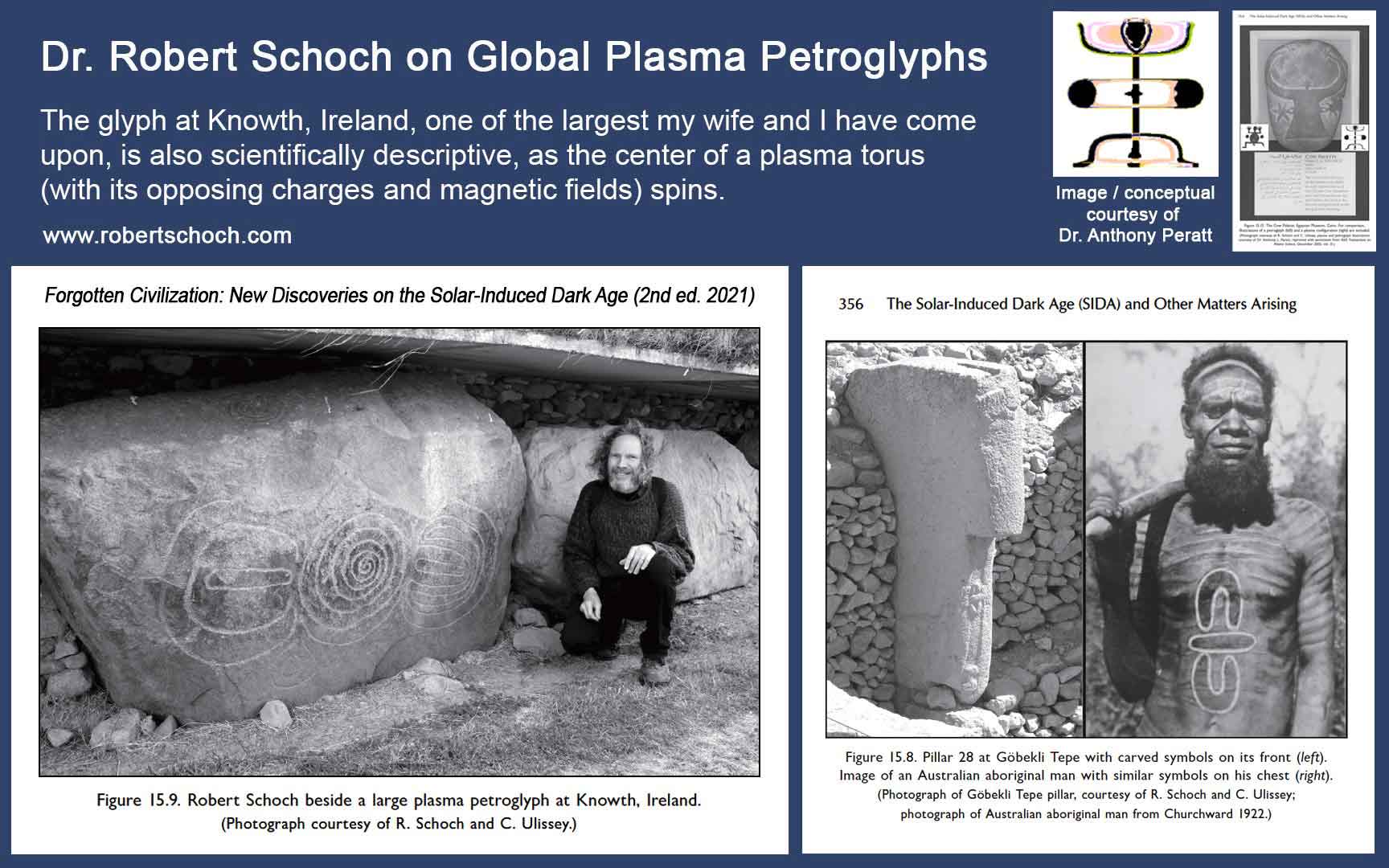
The Nazca Geoglyphs in Comparison to Easter Island's Rongorongo and Petroglyphs
Katie and I suspect that Nazca's giant geoglyphs were made when plasma configurations occurring in the sky (during an extreme solar event in prehistory) were actually so strong they drove down to ground level and branded the Earth. The shapes were remembered in different ways in different places on earth (and by different artisans). Not forgetting that ancient people revered the Sun, acknowledging that it was a manifestation of the Divine, through time the geoglyphs were walked, chalked (to reflect perhaps where God touched the Earth), remembered (if only in some fashion), and revered.
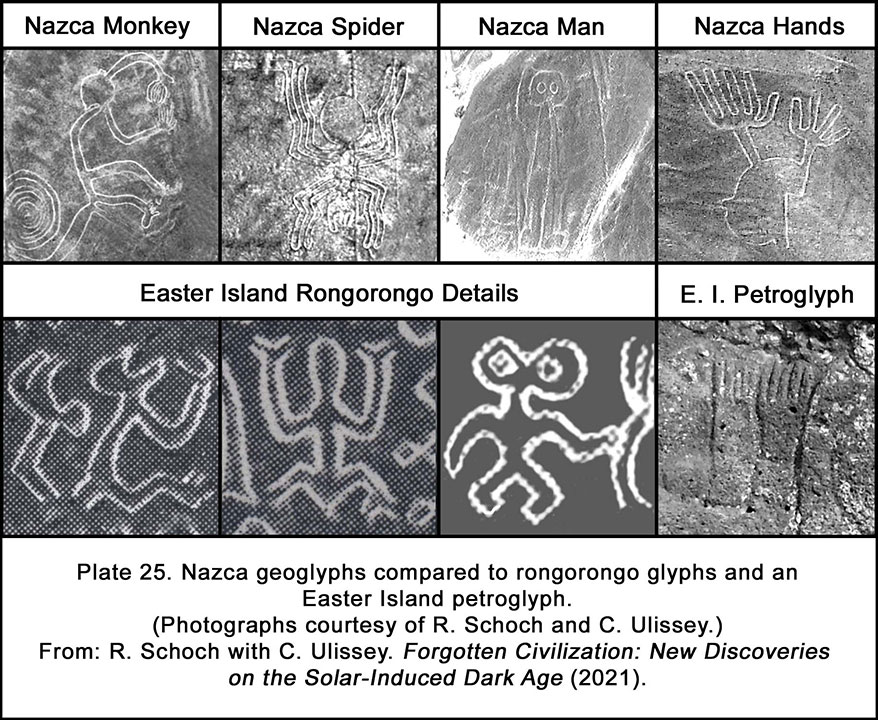
The Message of the Khafre Statue: We Become the Sun!
Once we understood that plasma takes on distinct (diagnostic) shapes, we started to see
these shapes abundantly in ancient art across continents (of course, always being wary not to
mistake nondescript forms for plasma shapes). It seems ancient artisans, understanding
that the cataclysms of c. 9700 BCE would be ushering in a new age of decline, plummeting humanity
down into the lower Yuga cycles where information would be lost, they sought to record important
information regarding our existence in art. The message of this particular statue, as we are coming
to understand the science, is: We become the Sun
; or Upon plasma / hydrogen we are carried
back to the stars
.
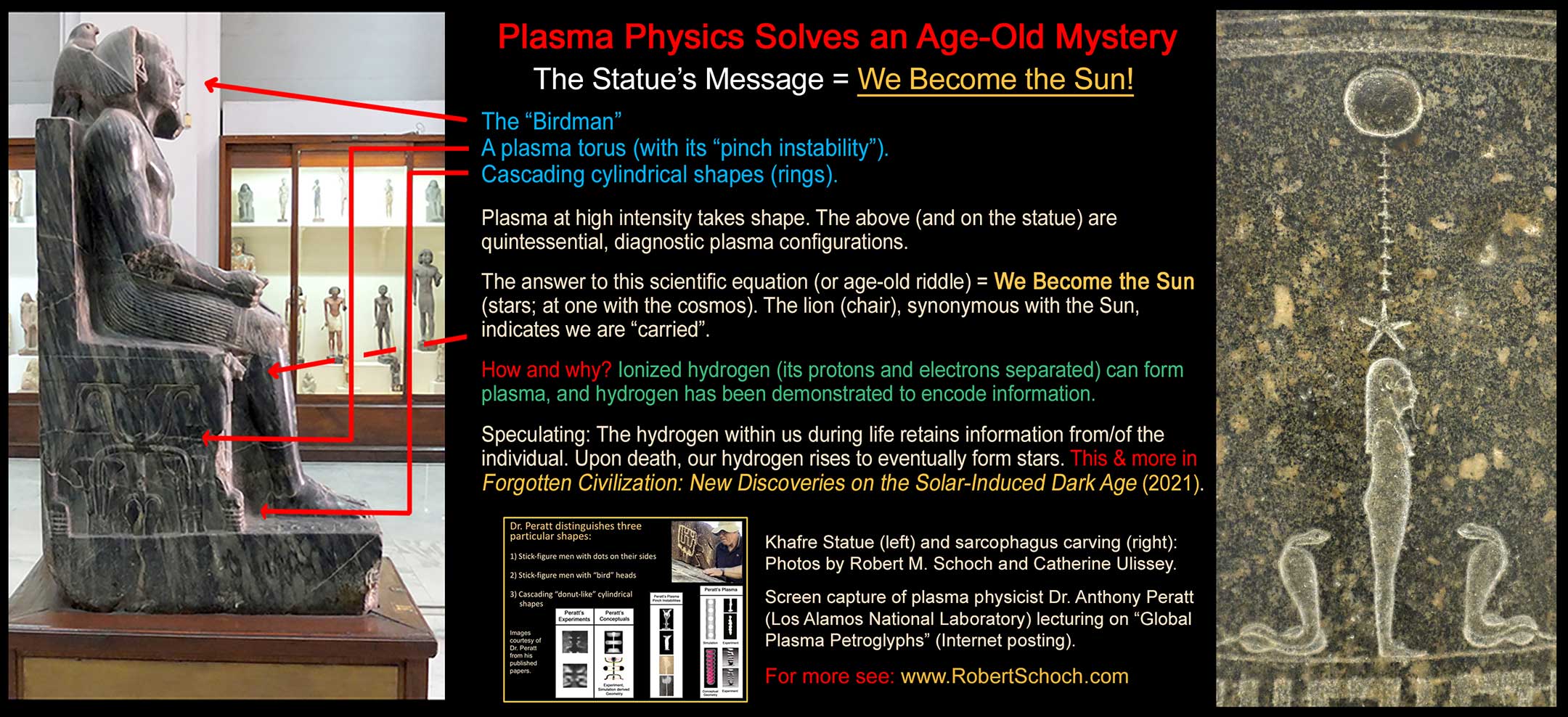
The Ancient Sufi Dancers, also known as Whirling Dervishes
:
This is one of our favorites; it seems the same was so for many people on social media.
We have been contemplating plasma (charged particles) a great deal of late. For those
who need a bit of science to help with this one: A hydrogen atom is comprised of a proton and an electron.
When the electron is stripped from its proton, as can happen in the extreme temperatures of stars/Suns,
the resulting particles carry electrical charges and many such particles will form an ionized gas
that can be referred to as a plasma. Plasma is ubiquitous in the universe. Combining the work of
Dr. Luc Montagnier (Nobel Laureate), who demonstrated (via DNA replication in water) that hydrogen
can encode information, and also the ancient maxim As above, so below
, the following meme
is what emerged.
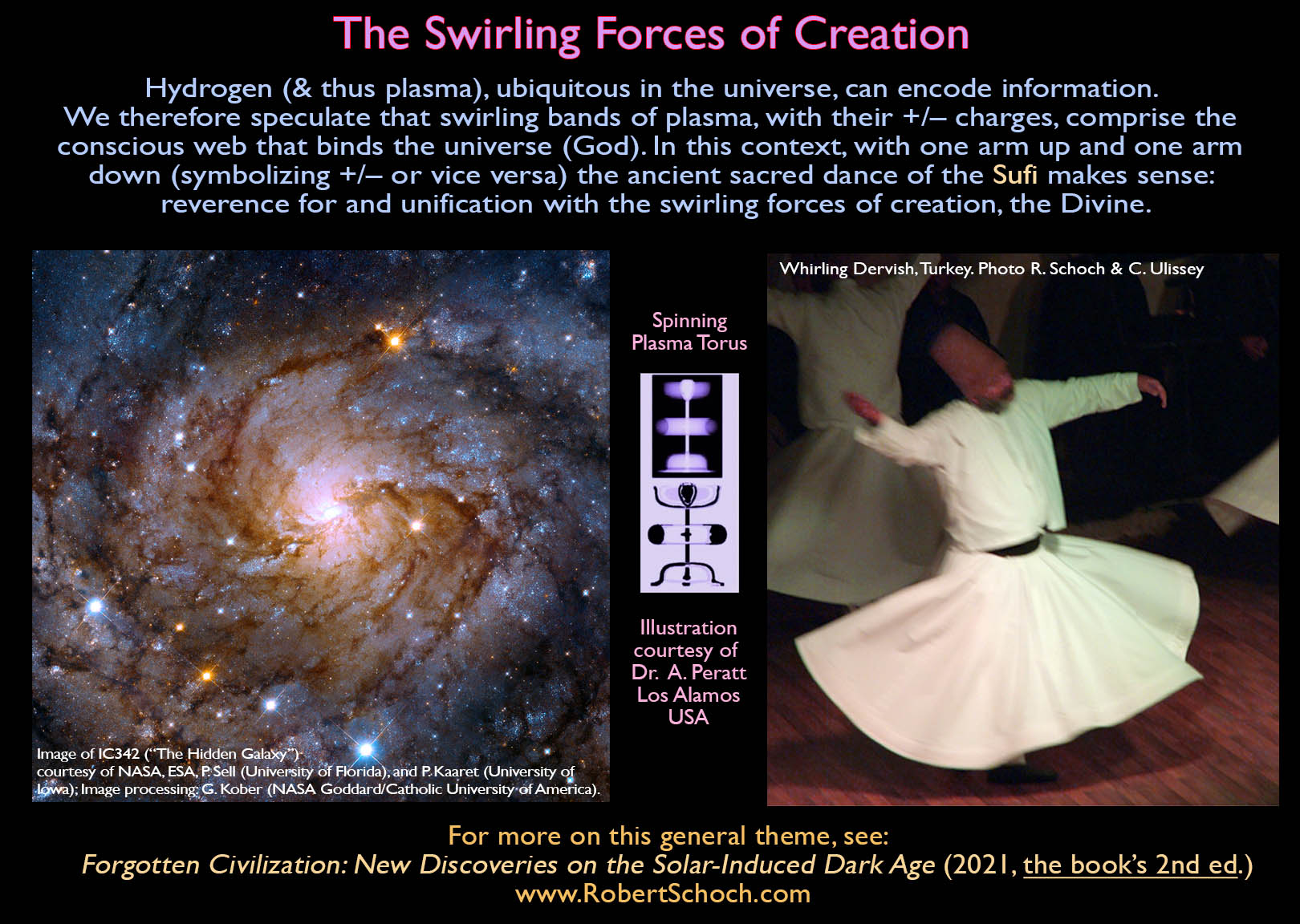
The Cart Ruts on Malta:
Again tying in with the concept of our Sun, via a giant explosion(s), bringing an end to high culture in prehistory, Katie and I wonder if we need to look at geology in some places with new and better eyes. Preconceptions can create problems.
Do the cart ruts fall off into the ocean or, rather, emerge from it? We suspect the latter, due to melting glaciers, rising sea levels, inundation, etc. The ruts look like marks made by people frantically scurrying rising seas, their tracks going in all directions. Scorching plasma could explain what we see: melting glaciers, rising seas, torrential rain (from the moisture pumped into the atmosphere, which could only hold so much water before precipitation), etc. The geology of the island nation is complex, but I must say that the ground in this area felt aerated, light, as if bubbled due to vitrification.
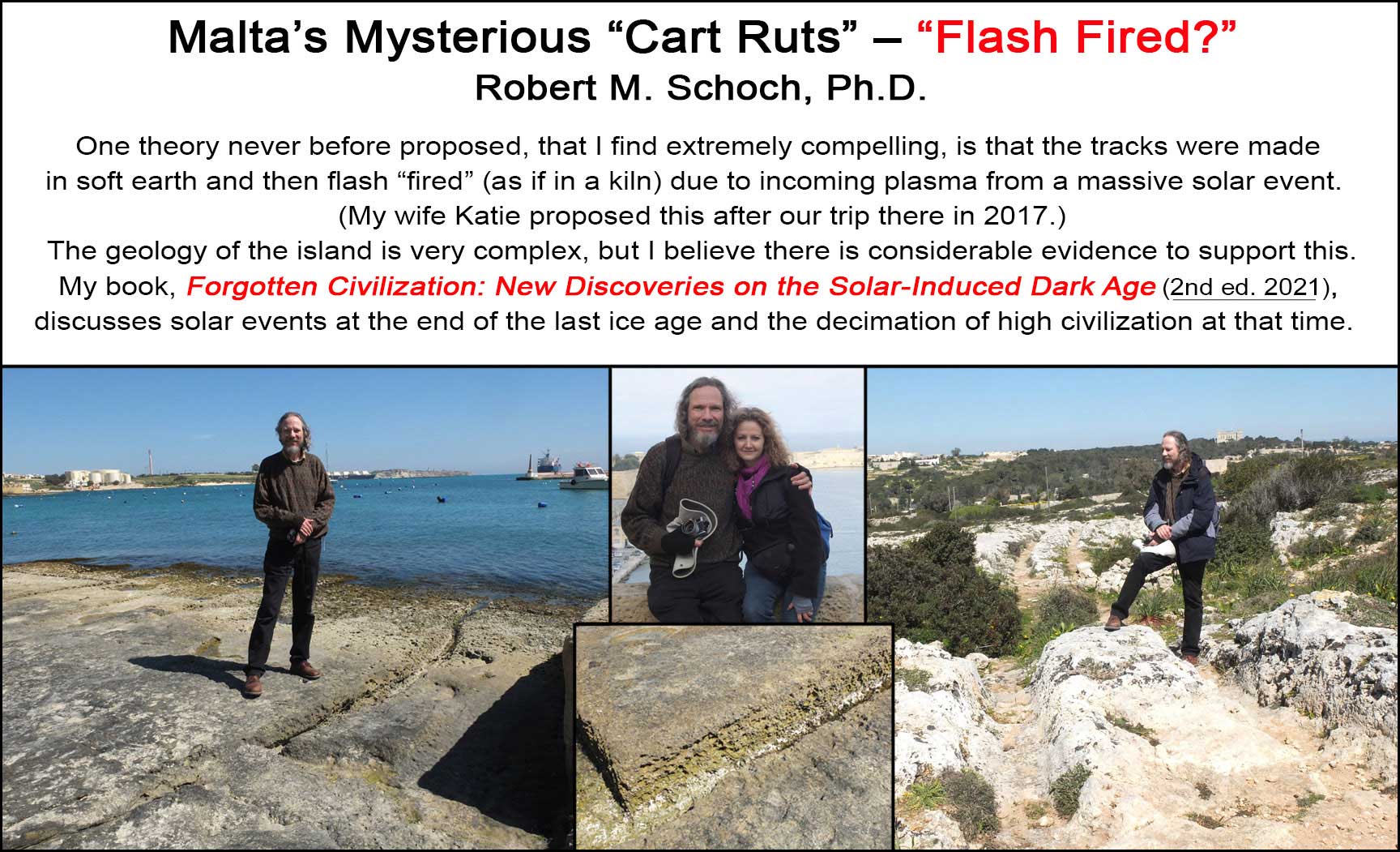
Joy to the World, our Statue from Papua New Guinea that is also a Plasma Torus:
While conducting research on the Internet one day, Katie came across this beautiful and old (though not
ancient) carving from Papua New Guinea. It is a literal plasma torus, including the two outbursts on the
sides (representing synchrotron radiation). We believe the shape is an homage to (or remembrance of) the
Divine (God, the Sun, etc.). Katie bought it and gave it to me as a holiday gift and, of course, I love it.
We decided to name it Joy to the World
. Additional joy came when we propped it up near our television
one night, just by chance, and noticed that it looked a bit like Stephen Colbert, whom we enjoy watching in
the evenings (he makes us laugh, and that is a nice way to end a day). We thought others might enjoy the
connection as well. (Stephen Colbert has a slightly unusual [pointed] right ear, which he jokes about on
occasion.)
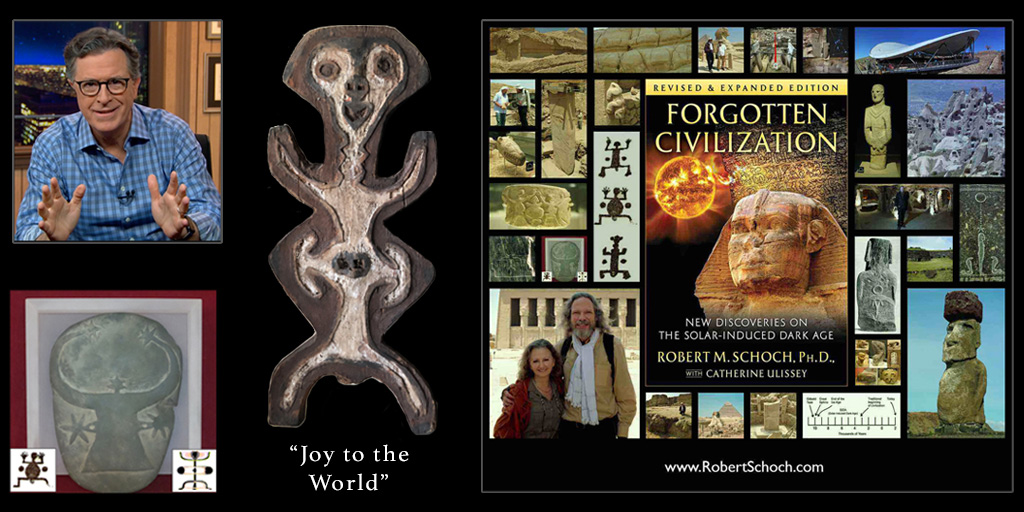
Star Trek Voyager's Distant Origin
Episode (Season 3; Episode 23):
Katie and I very much enjoy the various Star Trek stories (their television episodes, spin-off series,
films, etc.). Voyager's Distant Origin
episode seems ostensibly inspired by Galileo's
life story. However, many people have told me they think it was inspired by the research John Anthony West and
I presented to the world in the early 1990s (the water-weathering on the Great Sphinx, demonstrating that
civilization extends to a more distant point in our prehistory), as the episode was released not long after our
presentations at the GSA and AAAS (meme #1 at the top of this page). Galileo proposed heliocentrism; we
proposed more distant origins
for civilization (advanced culture). The short-term results
seem to have been the same: Refusal to accept data that challenges authority and its dogma, etc.
What a trek pursuing this research has taken me on for the last 30+ years of life! Katie (an Emerson College graduate) has written a superb screenplay outline (the inside scoop told by those who lived it!). We are hoping to connect the outline to a filmmaker who can bring it to the world. (Assistance along these lines would be appreciated. The outline has been copyrighted and we have a lawyer/friend who would be happy to submit it, which are the usual requirements for such. Our thanks in advance for your consideration.)
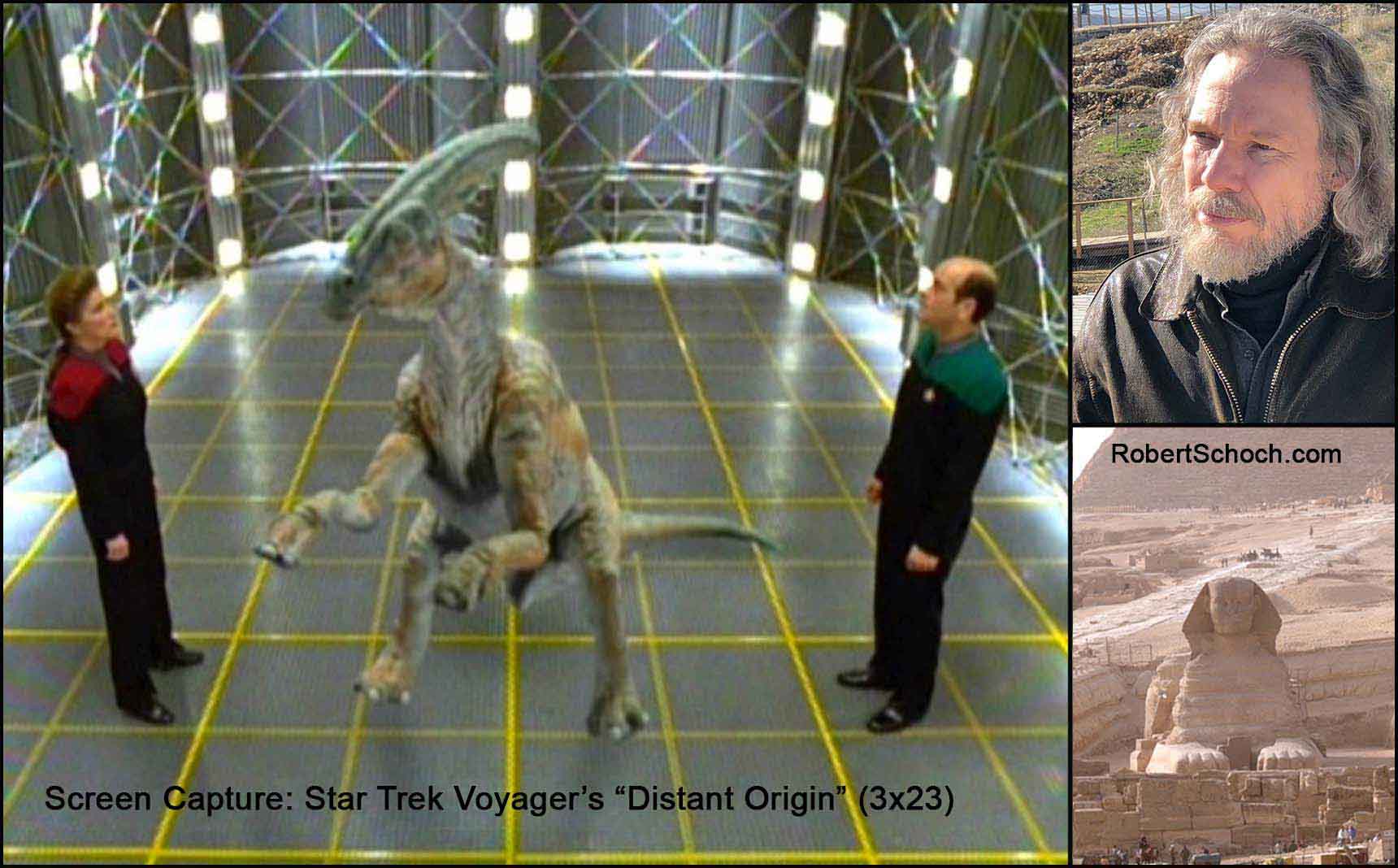
Cahokia Mounds:
With COVID-19 moving toward our rear view mirrors (hopefully), Katie and I did a little traveling this
past summer (2022). The primary reason was for work (we are striving to complete a documentary with
ORACUL that was begun just before the pandemic hit). We also had a private
function to attend in Illinois. While in the vicinity, we decided to visit the Cahokia Mounds in the
south-western part of the state. The mounds are the remnants of a pre-Columbian Native American city that
existed c. 1050–1350 CE. Tying in directly with our work, we came upon references to the birdman
at
this City of the Sun
. Note: This is not one of our better personal photos. One day into our trip the
airconditioner of our car broke, leaving us driving through incredible summer heat with only an open window
for relief (impossible during afternoon rain storms). With a tight schedule to keep, we had no choice but
to endure. It was also a masks on
summer for us, for myriad reasons, compounding the stifling
excursion.
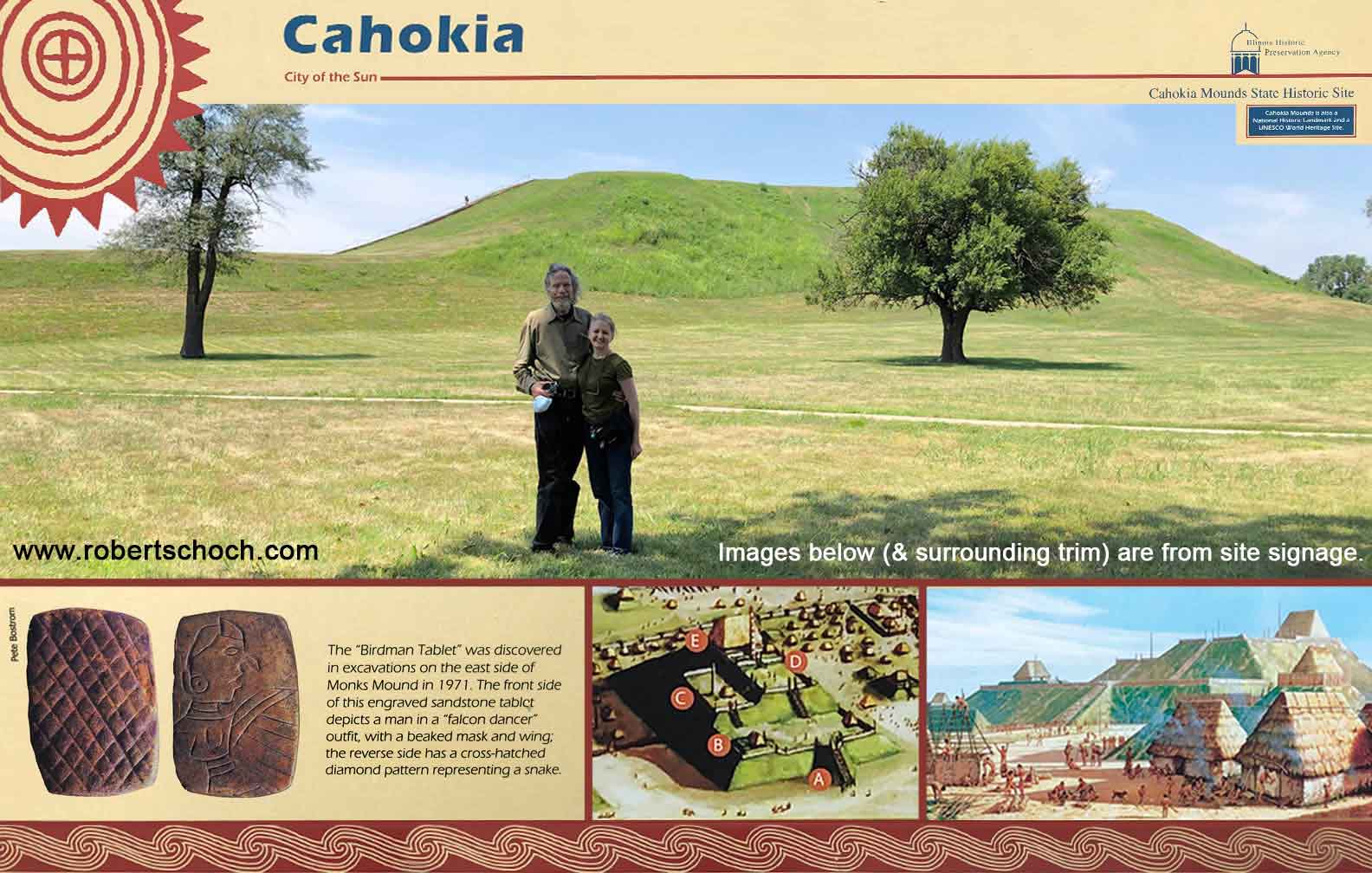
King Tutankhamun's Breastplate: Was Its Crown Jewel Made By The Sun?
This past summer (2022) there was a bit of a brouhaha on social media regarding the assertion that the crown jewel in King Tutankhamun's breastplate was made from Libyan Desert glass that was supposedly formed when a meteorite hit the Earth. While I agree that the glass was created from intense heat, I believe that it was not a meteorite that formed it, but rather scorching plasma from a massive solar event.
Katie had some additional comments subsequent to my original posting of this meme. I offer them here.
She titled them (in the comment section of the posting): We Become Stars, Not Bolides
.
The scarab is a symbol of rebirth, life as a star and/or among the stars after death.
It makes sense to Robert and me that placed as the centermost jewel in this magnificent
piece of art is a stone forged literally by a star itself, our Sun – that is, as Robert’s research
postulates, derived (or created) from a solar plasma strike and not a meteoritic impact event. Similarly,
it makes sense (at least to us) that King Tutankhamun’s dagger, perhaps symbolic of death (or the end
of this life), would be made of meteoritic iron. Of course, this is all just speculation on my part;
however, we have found so much science encoded in ancient art (symbols explained by plasma physicists
such as Dr. Anthony Peratt at Los Alamos and Dr. C. J. Ransom, utilizing cutting-edge plasma physics
technology) that each time we look at ancient art now we try to not only see its beauty but hear its
message. Also, it has been demonstrated in plasma labs that electrical discharges can create
double bull’s-eyes
, that is a circle within a circle. This is the astrological (ancient and
modern) symbol for the Sun and it is also seen on this breastplate. Perhaps the shape represents the
very thumbprint of the Sun itself. Reiteration! It is as if the breastplate itself is saying Listen!
Hear me! I am speaking of the Sun!
And if we don't catch one phrase in the art, perhaps we will
hear/recognize the other. And with hydrogen, ubiquitous in the universe, demonstrated to possess the
capacity to encode information (see the work of Nobel Laureate Luc Montagnier – we present his work
in our book), the all-seeing
eye of Horus makes sense at the top of the design.
A conscious universe. The whole piece is screaming Plasma
, the 4th state of matter. As we
speculate: the hydrogen within us during life encodes our information
. Upon death, being light,
it floats to the heavens where it combines with other hydrogen to one day again form stars. And so
this breastplate adorns the dead king. He becomes the birdman
(a quintessential plasma configuration),
just like the Khafre statue. Put another way: He becomes the Sun (a star).
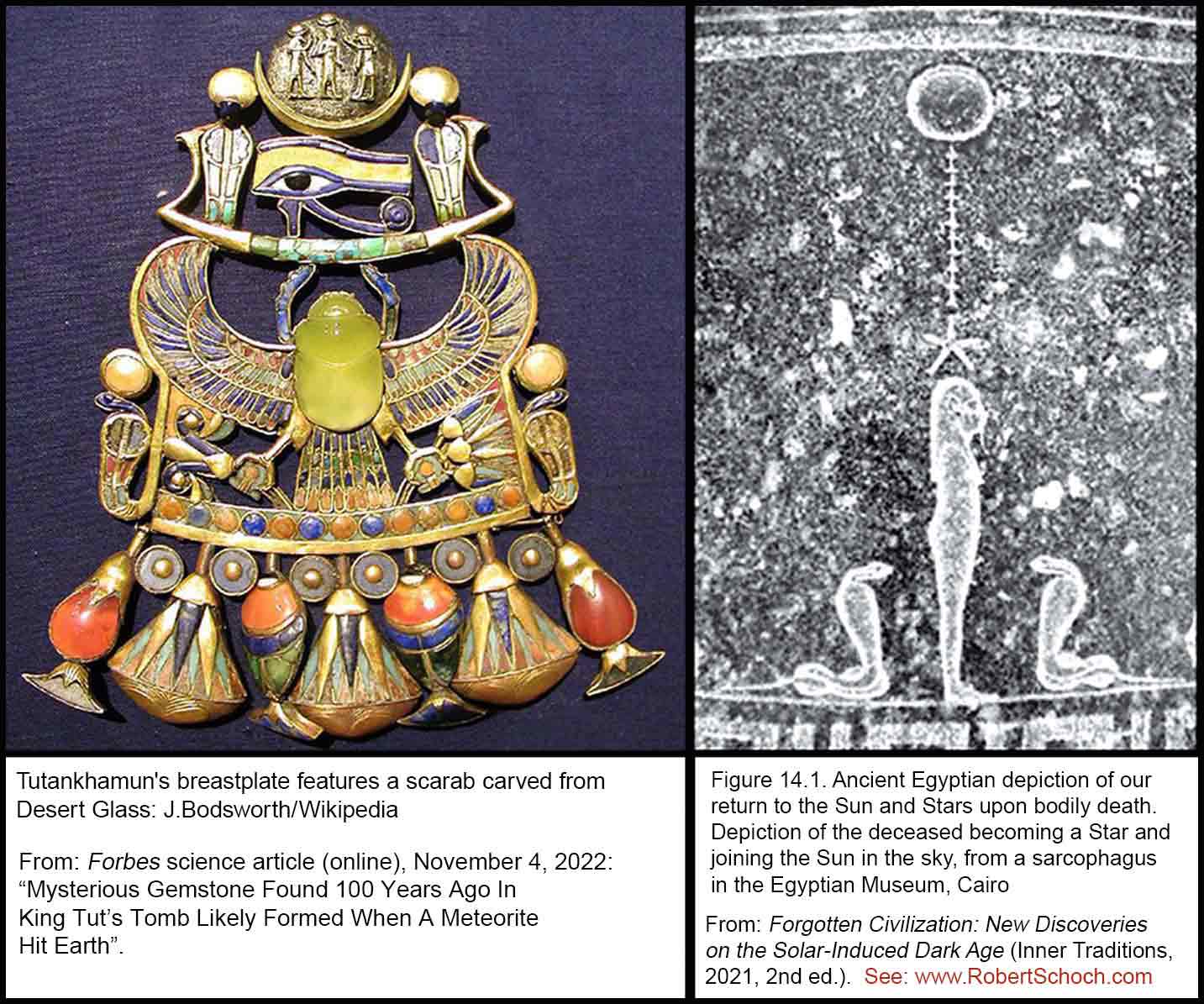
Thoughts on Today's Polarizations:
Katie's first published article, which we subsequently posted to this website over two years ago,
is titled Does the Water Bearer Bring Forth a River of Fire?
. It was originally written
for the National Council for Geocosmic Research's (NCGR's) eNews publication,
the April 14th, 2020, edition. Katie is a student of astrology (see her page
on this website for more about her). My research, and the work she and I are pursuing together,
led her to question why Aquarius, an astrological Air sign, is also called the Water Bearer
.
Is the term a warning from the Ancients regarding plasma, the cosmic currents? Katie felt that
writing this article might also introduce the astrological community to my work, something I of
course appreciated. Interestingly, subsequent to the publication and posting of
the article, Katie's thoughts regarding our research continued to develop. In the ensuing three
years, she has posted four postscripts that are, while speculative, extraordinarily interesting.
Indeed, I am exploring her propositions for possible inclusion in my forthcoming book. You
can read Katie's article here. If you would like to
read the information that pertains directly to this meme, scroll to the bottom of the article.
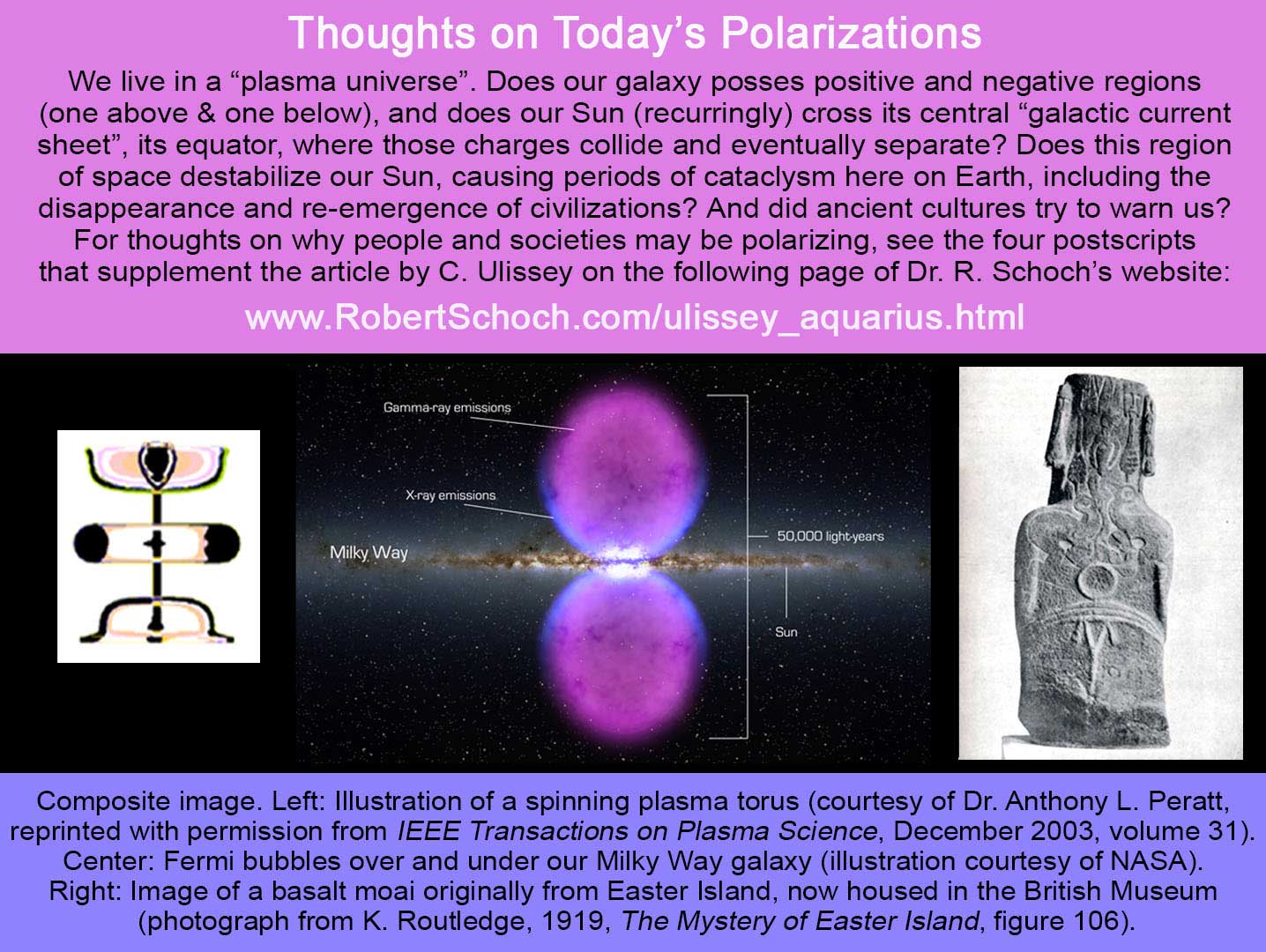
Our Beautiful Book:
The first edition of Forgotten Civilization was published in 2012 and has been translated into several European languages (Italian, German, Polish, and Romanian). Ten years passed (and our research made great strides), so our U.S./English-language publisher, Inner Traditions, decided to release a 2nd (revised & expanded) edition that would also have an audio version. We are very proud to say that book was released in March of 2021, bearing the new subtitle, New Discoveries on the Solar-Induced Dark Age. Excluding nothing from the original edition, the updated book contains 150 new/additional pages of text, including updates throughout, a new chapter at the end, and 40 new black and white photos interspersed throughout the chapters. Also, and very importantly, this new edition is now available in Spanish, published by Grupo Planeta in Spain.
If you have read our book, thank you. If you have friends whom you think would enjoy it, we would appreciate it if you would recommend it to them. And lastly, if you have a moment to give the book a kind (5-star) rating on Amazon (or whatever online reading center you might frequent, such as Goodreads, etc.), we would really appreciate it. It helps so very much with auto-marketing, which we cannot control. Your clicks and ratings control much in today's world. (If you click the image below, it will take you directly to the book's page on Amazon U.S.A.)
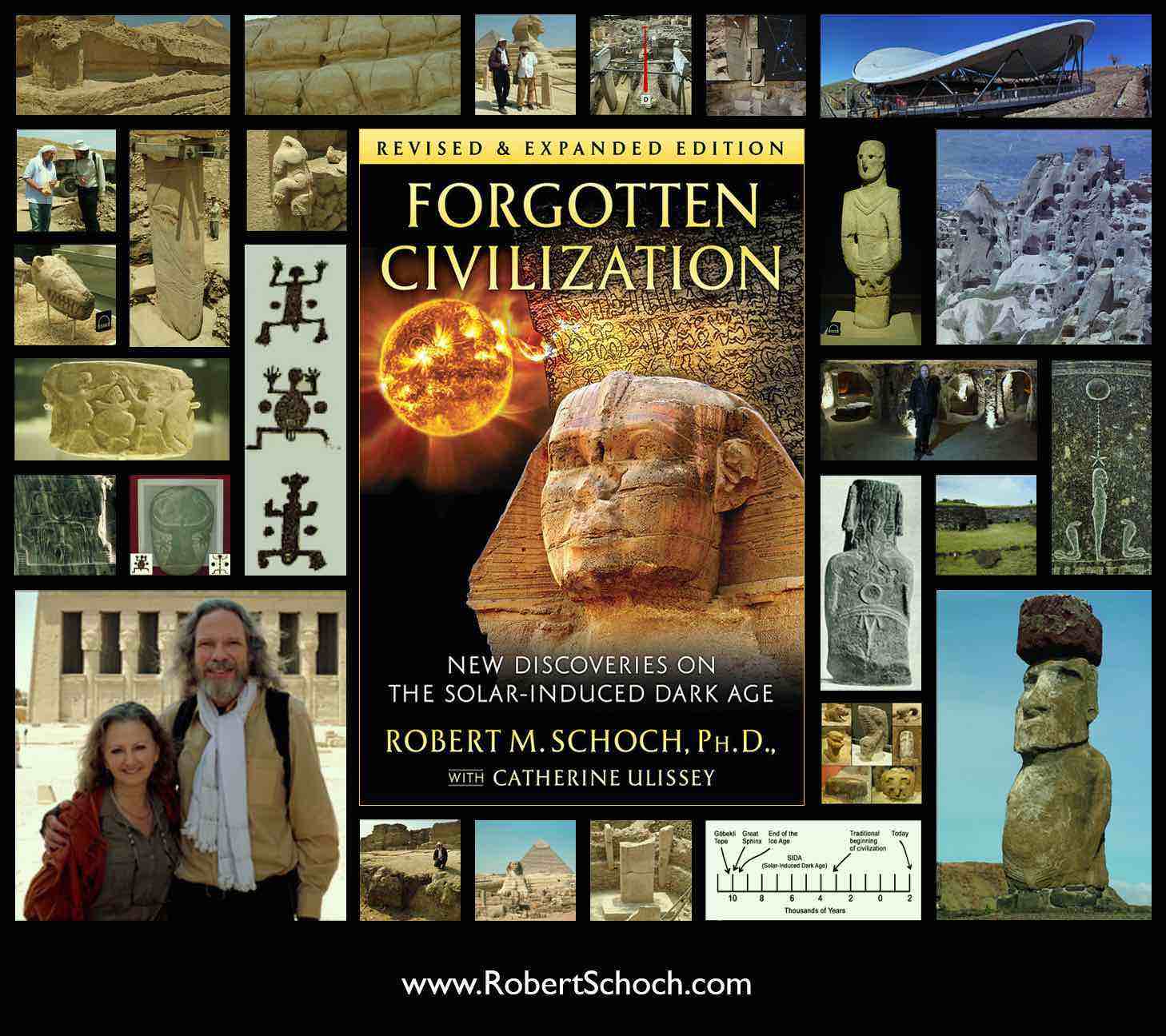
And here is the Spanish release:
